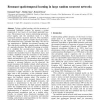Free Online Productivity Tools
i2Speak
i2Symbol
i2OCR
iTex2Img
iWeb2Print
iWeb2Shot
i2Type
iPdf2Split
iPdf2Merge
i2Bopomofo
i2Arabic
i2Style
i2Image
i2PDF
iLatex2Rtf
Sci2ools
BC
2002
2002
Resonant spatiotemporal learning in large random recurrent networks
Taking a global analogy with the structure of perceptual biological systems, we present a system composed of two layers of real-valued sigmoidal neurons. The primary layer receives stimulating spatiotemporal signals, and the secondary layer is a fully connected random recurrent network. This secondary layer spontaneously displays complex chaotic dynamics. All connections have a constant time delay. We use for our experiments a Hebbian (covariance) learning rule. This rule slowly modifies the weights under the influence of a periodic stimulus. The effect of learning is twofold: (i) it simplifies the secondary-layer dynamics, which eventually stabilizes to a periodic orbit; and (ii) it connects the secondary layer to the primary layer, and realizes a feedback from the secondary to the primary layer. This feedback signal is added to the incoming signal, and matches it (i.e., the secondary layer performs a one-step prediction of the forthcoming stimulus). After learning, a resonant behavio...
| Added | 16 Dec 2010 |
| Updated | 16 Dec 2010 |
| Type | Journal |
| Year | 2002 |
| Where | BC |
| Authors | Emmanuel Daucé, Mathias Quoy, Bernard Doyon |
Comments (0)

